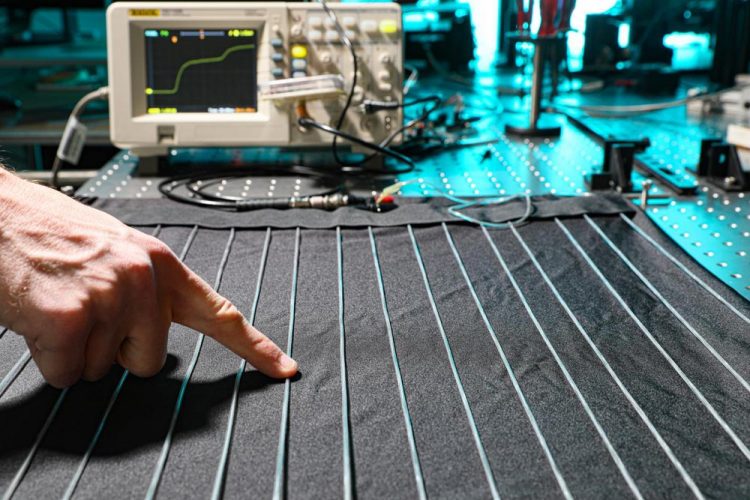Smart textiles made possible by flexible transmission lines

EPFL researchers have developed electronic fibers that, when embedded in textiles, can be used to collect data about our bodies by measuring fabric deformation. Their technology employs flexible transmission lines and offers a host of applications, including in the medical industry. Credit: EPFL
“Imagine clothing or hospital bed sheets capable of monitoring your breathing and physical gestures, or AI-powered textiles that allow humans to interact more safely and intuitively with robots” says Leber. “The flexible transmission lines that we've developed can do all of this.”
Stretching, pressure and torque
The researchers invented a single sensor that can detect different kinds of fabric deformation like stretching, pressure and torque at the same time. “Finding a method for calculating all that was our biggest challenge, because it's really difficult for sensors to measure several movements simultaneously,” says Leber.
“Also, conventional sensors have several drawbacks. First, they are fragile and break easily. Second, you need a lot of them to cover a large area, which eliminates many of the advantages of fabrics. And third, each type of conventional sensor can detect only one kind of deformation.”
But by incorporating concepts from reflectometry, Sorin and Leber were able to create flexible fiber-shaped sensors that open up new doors for smart textiles.
“Our technology works similar to a radar, but it sends out electrical impulses instead of electromagnetic waves,” explains Leber. “Our fiber sensors operate like transmission lines for high-frequency communication. The system measures the time between when a signal is sent out and when it's received, and uses that to determine the exact location, type and intensity of deformation.”
This kind of detection technology has never before been used in applications requiring high mechanical flexibility and powerful electronic performance, which are two key features for distortion identification.?
Liquid metal and fiber optics
Creating the fibers is a complex task involving liquid metal, which serves as the conductor, and an optical fiber fabrication process. “The structure is just a few micrometers thick and has to be perfect, otherwise it won't work,” says Leber. With these fibers, the entire surface of a fabric becomes one large sensor.
“The trick was to create transmission lines made entirely of flexible materials, using a simple method that can be scaled up easily,” adds Sorin. The team's research drew on a variety of disciplines including electrical engineering, mechanical engineering, materials science and process engineering.
The next step will be to make the technology more portable by shrinking the electronic component.
Media Contact
All latest news from the category: Materials Sciences
Materials management deals with the research, development, manufacturing and processing of raw and industrial materials. Key aspects here are biological and medical issues, which play an increasingly important role in this field.
innovations-report offers in-depth articles related to the development and application of materials and the structure and properties of new materials.
Newest articles

Bringing bio-inspired robots to life
Nebraska researcher Eric Markvicka gets NSF CAREER Award to pursue manufacture of novel materials for soft robotics and stretchable electronics. Engineers are increasingly eager to develop robots that mimic the…

Bella moths use poison to attract mates
Scientists are closer to finding out how. Pyrrolizidine alkaloids are as bitter and toxic as they are hard to pronounce. They’re produced by several different types of plants and are…

AI tool creates ‘synthetic’ images of cells
…for enhanced microscopy analysis. Observing individual cells through microscopes can reveal a range of important cell biological phenomena that frequently play a role in human diseases, but the process of…





















